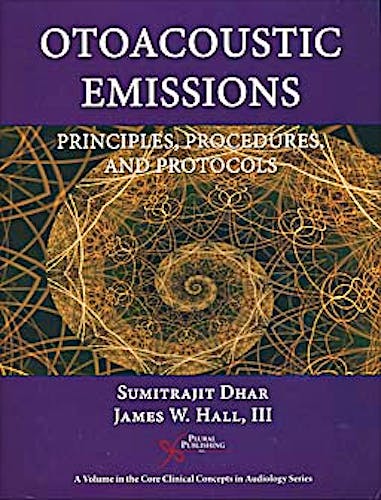

No hay productos en el carrito



Otoacoustic Emissions. Principles, Procedures, and Protocols (Series Core Clinical Concepts in Audiology)
Dhar, S. — Hall, J.
1ª Edición Junio 2011
Inglés
Tapa blanda
150 pags
602 gr
22 x 28 x 1 cm
ISBN 9781597563420
Editorial Plural Publishing Inc
LIBRO IMPRESO
-5%
59,15 €56,19 €IVA incluido
56,88 €54,03 €IVA no incluido
Recíbelo en un plazo de
2 - 3 semanas
Overview
Otoacoustic emissions now play an important role in hearing screening and the
clinical assessment of children and adults. However, a new wave of evidence
is challenging our fundamental understanding regarding OAE sources and mechanisms.
Similarly, just as we have settled on methods and protocols for clinical uses
of otoacoustic emissions, ongoing research suggests new opportunities for evidence-based
clinical applications. In Otoacoustic Emissions: Principles, Procedures, and
Protocols, Drs. Dhar and Hall have collected the latest information on OAEs
– from basic research to clinical applications. The book is concise, but
comprehensive, and covers the essentials of the subject from innovative and
up-to-date perspectives. The material covered in the book is appropriate for
intermediate and advanced students, and ideal for practitioners. With a consistent
focus on practical information needed by the clinical audiologist, and a eye
to future developments, authors Dhar and Hall systematically raise and answer
questions necessary for a thorough understanding of OAEs, and an appreciation
of their clinical value.
Table of Contents
•Preface
•Overview of Otoacoustic Emissions
•Anatomy, Physiology, Mechanisms, and Theory
•Outer hair cells are the locus of generation.
•But where is the nonlinearity, hair bundle or somatic motility?
•How do emissions return to the ear canal?
•If there are reflection emissions, what is the reflector?
•Taxonomy for OAEs: Conventional and Alternative Theories
•Stimulus based taxonomy
•Place and wave fixed emissions
•Nonlinear and reflection emissions
•Instrumentation and Calibration
•Current standards (IEC)
•Calibration at the entrance of the ear canal: advantages and disadvantages
•How does calibration at the entrance of the canal influence interpretation of results?
•Alternate strategy for calibrating OAE stimuli
•Clinical Measurement of OAEs: Procedures and Protocols
•OAE Analysis (including non-pathologic factors and trouble shooting)
•Applications of OAEs in Children
•Applications of OAEs in Adults
•Suppression of OAEs as a Clinical Tool.
•New directions in Research and Clinical Application?
•References
•Glossary
•Appendices
•A. Basic science of OAEs
•B. Normative data
•C. Recipe for testing system distortion
About The Authors
Sumitrajit (Sumit) Dhar has studied Audiology and Hearing Science
at the Mumbai University (India), Utah State University, and Purdue University.
At Purdue, Sumit completed his Ph.D. in 2001 under the tutelage of Professors
Glenis Long and Arnold Tubis. Between 1992 and 2000, Sumit has held several
clinical positions as audiologist, audiology-supervisor, and clinic manager.
His first academic appointment was at Indiana University, Bloomington. Today,
Sumit is Associate Professor at the Roxelyn and Richard Pepper Department of
Communication Sciences and Disorders at Northwestern University, where he teaches
courses in audiology and applied hearing science and is actively involved in
the operation of the AuD program. Research in his lab is primarily focused on
the theory and practice of otoacoustic emissions as they relate to cochlear
mechanics and auditory behavior. His research is currently funded by the National
Institutes of Health and the Hugh Knowles Foundation at Northwestern University.
He has also received funding from the Deafness Research Foundation in the recent
past..
Dr. James W. Hall III is Clinical Professor in the Department
of Communicative Disorders at the University of Florida in Gainesville, where
he maintains a clinical practice and is an instructor in the Doctor of Audiology
on-site and distance learning programs..
Dr. Hall’s main research interests are auditory neurophysiology, auditory
processing disorders, early identification of hearing loss in infants, and tinnitus/hyperacusis.
Dr. Hall lectures internationally on these topics. He is the author of numerous
journal articles, monographs, or book chapters, as well as the Handbook of Auditory
Evoked Responses and Audiologists’ Desk Reference Volumes I and II, the
Handbook of Otoacoustic Emissions and the New Handbook of Auditory Evoked Responses.
© 2025 Axón Librería S.L.
2.149.0